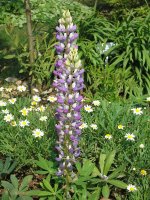 This afternoon the Outliers paid another visit to the Ashikaga Flower Park. We waited until the peak season crowds had cleared and the price had dropped, thereby saving ¥600 each at the cost of missing the Park's signature exhibit: the huge arbors of purple, white, and yellow blossoms hanging from massive wisteria trees (藤 fuji). But the great profusion of roses (バラ, bara), clematis (クレマチス, kuremachisu), and rhododendrons (シャクナゲ, shakunage) almost made up for it. And so did the chance to learn a little more about plants and their names—in English as well as Japanese.
This afternoon the Outliers paid another visit to the Ashikaga Flower Park. We waited until the peak season crowds had cleared and the price had dropped, thereby saving ¥600 each at the cost of missing the Park's signature exhibit: the huge arbors of purple, white, and yellow blossoms hanging from massive wisteria trees (藤 fuji). But the great profusion of roses (バラ, bara), clematis (クレマチス, kuremachisu), and rhododendrons (シャクナゲ, shakunage) almost made up for it. And so did the chance to learn a little more about plants and their names—in English as well as Japanese.上り藤 noborifuji 'ascending wisteria' - Although we missed the hanging wisteria, we discovered another plant still in bloom whose nickname in Japanese is 'ascending wisteria': lupines, also called ルピナス, rupinasu (pictured above). I remember first reading about lupines while devouring a lot of Steinbeck during language school in Monterey, California, but had never really studied them up close, and had certainly never compared them to wisteria.
石楠花 shakunage 'rhododendron' - When I checked the labels and read their name in kanji, it took me a good while to figure out that what seemed to be seki+nan+ka 'stone+camphor+flower' was actually read shaku+na+ge and meant 'rhododendron'. That's why plant identification labels in Japan usually render the names in katakana.
つるバラ tsurubara 'rambling rose' - When we first encountered a long hedgerow with trellises, the flowers didn't look like roses, but a nearby label identified them as tsurubara カクテル (kakuteru, 'cocktail' probably meaning 'hybrid'). The flowers looked a bit like John Cabot explorer roses, but with golden centers. They turned out to be just one of the varieties of rambling roses (or climbing roses) on display in the park.
No comments:
Post a Comment